Dispatch: Wisconsin Film Festival
Jimbo’s Wrap-up: Thoughts on the second half of the 2015 Wisconsin Film Festival
There’s too much to say about the 2015 Wisconsin Film Festival: most of what remains to be said is good, but there are some lingering concerns that will play themselves out as we learn more about this year’s attendance. What I don’t touch on, hopefully Jake will address in his Festival wrap-up later this week.
Overall, as always, the programming itself was strong. But that is coming from someone who wants to see everything. The real question will be how long general audiences will stay with Wisconsin Film Festival “deep cut” programming. (For a different take on the “deep cut” question, see the wrap-up at LakeFrontRow.)
Strong in the Homestretch
First, I should answer a question I posed in my dispatch on Monday: “Were audiences already done by Sunday night?” My answer, based on audiences I observed on the final four days at Sundance, is a definite no. There were several well attended screenings with very enthusiastic (and perhaps well rested, if they took Sunday off) audiences.
On Monday, A Hard Day and The Astrologer had strong responses, and later in the week both screenings of The Russian Woodpecker were very well attended with enthusiastic audiences. The audience for the final screening of the Festival, Polyester, was also ready to play, despite the fact that the Odorama cards were kind of a dud. (“Oh yeah,” I said to myself when I sniffed 8 out of 10 with the same indistinct smell, “I forgot that it was kind of like this when I saw it with the cards in 1989, too.”)
The major disappointment crowd wise was for Todd Rohal’s Uncle Kent 2, which worked its way up into the Top 10 of my 2015 favorites. Rohal was unable to attend, but he and star Kent Osborne were able to field questions through the phone of (Madison-born) producer Mel Eslyn. This ended up being one of the more delightful (and refreshingly unpretentious) Q & A sessions of the Festival, as everyone acknowledged that very few people seem to want to see this film. That time slot was not unsuccessful for the Festival, however; the Tuesday night screening of In Order of Disappearance, opposite of Uncle Kent 2, was completely packed.
My guess is that overall attendance for 2015 will be down, perhaps even significantly down, but I hope to be very wrong about that. More importantly, it is time for the Festival to get ahead of the numbers game by defining success on its own terms rather than raw attendance numbers. As Sean Weitner showed us last year, it would be very difficult, if not impossible, for Festival numbers to grow in its current configuration. But with a clearer mission statement, beyond just showing good films for eight days, the success and significance of the Festival could be discussed in very different and more productive terms.
Edit 4/24/15: On Facebook and Twitter, the Festival reported a 2015 attendance of 26,506, which is slightly lower than the previous low in 2013 of 26,714. I had hoped to be wrong about attendance, but I honestly didn’t think it would be a record low. It is hard to interpret that raw number given many variables from year to year, so we hope to return to the topic of the “new normal” for Festival attendance in the coming weeks.
Sundance Logistics
On Monday I complimented the Sundance staff and Festival volunteers for making things far less hectic this year. I had a bit more time in the last four days to try to figure out what was different.
In a nutshell, the clear difference was that the area in front of the theater hallway opening never seemed chaotic, which had a big impact on how I perceived and experienced the entire space. The great move (and perhaps they did this last year and I didn’t notice) was to move the rush ticket table to the side opposite of the hallway enterance, and form the rush ticket line in the empty stairwell to the currently unused second floor. When learning about the Sundance space for our rooftop Madfilm Meetups last year, it occurred to me that the Festival should figure out a way to utilize this now-empty second floor space, even if it increased the overall rental. While I’d still like to see a social use for that space (for reasons I’ll come back to in the next section) the use of that stairwell alone was an inspired move.
The spacing between Sundance screenings seemed to work better this year, even though to get a good seat you still have to pretty much get out right away and back into a new line. The downside to this is that it makes it even harder to make it back and forth between venues, as there are more screening overlaps between Sundance and other venues (when you factor in transportation and parking time). But ultimately this is the lesser of two evils, because the smoother experience at Sundance is worth that sacrifice (especially if you’ve already committed yourself to minimizing crosstown commutes).
The folks at LakeFrontRow have reported that there was some grumbling about Sundance on Twitter, and certainly there were some isolated incidents that could have gone more smoothly (for example, why did it take over 20 minutes to clear the auditorium after Güeros?). But for the most part, once audiences understood the system, it ran smoothly. So let’s give credit where credit is due: The Festival and Sundance got it right this year, and it was a much more pleasant experience. [Edit: In the comments below, volunteer Gretta Wing-Miller mentions the important role of volunteer coordinator Bernadette “Birdie” Watts in the Sundance experience this year. Well done, Birdie!]
Post-Screening Socializing
I don’t consider myself a cool kid, but I know where the cool kids go. And one place they don’t go, and probably never will, is the Edgewater’s Statehouse Bar. I hate to say this and sound like an ingrate, because I did enjoy a complimentary Spotted Cow or two. The Festival had a series of great ideas for post-screening social opportunities at the Statehouse, but they forgot three important rules: location, location, location.
I went to two of the post-screening gatherings at the Statehouse and found the same thing on both nights: staff members who needed a well earned drink, and visiting filmmakers who were probably wondering where the other bars open past 12 am were. As far as the general public, or any sense of an extended social family of Festival fans, forget it. They were clearly invited during the introduction to every screening. They just didn’t go.
The Thursday night volunteer party at The Great Dane-Hilldale, on the other hand, was exactly what the Festival social events should be like: lively, energetic, and, dare I say it, young. Someone finally remembered that not all students have motor vehicles, and they like to walk to social events. The relief of just walking from a screening to a social venue where a lot of film fans I’ve never met before were also gathering gave me a pleasant flashback to 2000. In addition to having a more distinct hub for the Festival in general, it would be nice to return to the idea of a social hub for the Festival, one that is easily accessible after screenings.
That social hub would not necessarily have to be downtown, there are relatively hip options near Hilldale including the Great Dane and Oliver’s Public House (on Old University). But downtown there are certainly better candidates than the Statehouse, especially in the so-called Tribeca area (Triangle Behind Capital): Merchant, Great Dane, Natt Spil, Argus, Majestic, and the upcoming Lucille in the current Isthmus building (the later two might present all-ages opportunities for certain kinds of gatherings). And there would be various ways to do this without offending the Edgewater as a sponsor (the Concourse was never much better as a social hub). But before determining any such social hub, again the Festival would need to come up with a clearer mission for the social events.
And, as I hinted at in the last section: Another option would be to rent the mostly unused second floor of Sundance for social events. Based on how empty it is most of the year, it has to be in the interest of Sundance to showcase that space during a busy Festival to prospective customers for the rest of the year. If Sundance doesn’t see it that way and would make the rental prohibitively expensive, then it would not be worth it because as it is it is not a “go to” location. But it would be great to walk to something fun every night.
The 2016 One Less Club
These categories don’t need to be eliminated, there’s room for all kinds of films at the Wisconsin Film Festival. But it might be a good idea to simply have one less film from each category to make more room for other kinds of films.
Drafthouse Films: This year had a near complete slate of the current lineup from Drafthouse: The Connection, The Keeping Room, The Look of Silence, Roar, The Astrologer. Drafthouse does great work, but to paraphrase Groucho Marx, you have to take your cigar out of your mouth every once in a while.
WTF Films: Obviously this overlaps a bit with the Drafthouse films (Roar, The Astrologer) but I would also extend this to the Cannon films which have been adequately covered in the regular UW Cinematheque schedule this year. Just one less, gang.
Swanberg Cinematic Universe: I keep using Joe Swanberg as a running joke in my Festival overviews, despite the fact that I like most of the films with which he’s involved. It would be interesting not being able to use him as a running joke next year because there aren’t enough films in which he appears in the credits.
My Top Ten
Films pre-screened before the festival are marked with an asterisk; the others were viewed with Festival audiences.
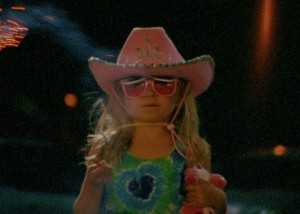 Tired Moonlight*
Tired Moonlight*
Too many post-mumblecore micro-budgeted indie filmmakers have only a great ear. Britni West has the best eye of the bunch, and the ability to hit you with a one-two punch of concrete imagery and lyrical voice overs. As I concluded in Isthmus, Almost every shot bursts with life as it is lived in Kalispell, Montana, and several memorable sequences have the concise impact of an imagist poem. See my capsule review in Isthmus.
Results
Andrew Bujalski might be one of those ear-centric filmmakers I just criticized in the review above. But with his special cast here (Guy Pierce, Colbie Smulders, and Kevin Corrigan) he crafts one of the most interesting and amusing relationship triangles in recent memory. Results might soon be caught in on-demand limbo, so look for it because it is unlikely to come back on the big screen.
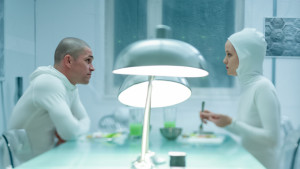 Free Fall
Free Fall
Take the structure of Brakhage’s Reflections on Black, and instead of psychodrama add healthy doses of surrealism, absurdity, and pitch black humor. The humor is admittedly hit or miss, as with most episodic films, but when Free Fall hits it provides suitably audacious and vivid images that you cannot soon forget.
La Sapienza*
A few people told me that there was laughter at both screenings of La Sapienza. This is why we can’t have nice things. Admittedly the Bresson-esque performance style and delibrately theatrical staging takes some getting used to, but that doesn’t mean we have to laugh at everything with which we are not familiar. If you allow yourself to play the game the film wants you to play, which is a grand old fashioned melodrama, you will find La Sapienza to be an emotionally rewarding experience, rather than just a stylistic oddity. See my capsule review in Isthmus.
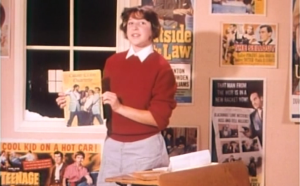 Crime Wave*
Crime Wave*
The Winnipeg film scene makes a lot more sense to me thanks to this wonderful piece of nonsense from John Paizs. The film seamlessly blends tones ranging from wonderfully endearing to disturbingly demented, and Paizs’s deadpan performance is matched in charm by young Eva Kovacs. This shows one advantage of the “deep cut” restoration programming approach: I would not have known about Crime Wave if it hadn’t been featured in the Festival. If all of the deep cuts were equally exciting, it wouldn’t matter if audiences buy in or not. See Jake Smith’s review for more on the film.
Tu Dors Nicole*
We’ll have more to say about Tu Dors Nicole with an upcoming guest review that missed the pre-festival deadline. I almost missed this myself, and it probably flew under the radar for many festival-goers. The film is wonderfully subtle with just enough crazy ideas to make it kind of magical. You know Nicole, or perhaps you are Nicole and don’t want to admit it. You dis Nicole, you dis yourself. That realization should bring a smile on your face, especially when thinking about the film much later.
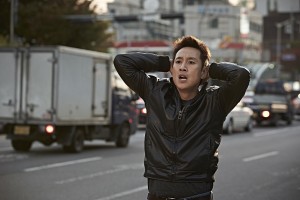 A Hard Day
A Hard Day
This is the fun world cinema genre film that White God was supposed to be. Despite trafficing in a few cliches, especially in the third act, there’s more than enough inventiveness and playfulness to make up for those shortcomings. A Hard Day features some of the most inventive (and funniest) use of props in recent memory, and it also wins the prize for “Best Use of a Cellphone” this year (and there were many legitimate contenders). This is the kind of film with ludicrous twists that make you smile instead of rolling your eyes.
En Plein Air (short)* / World of Tomorrow (short)*
Although not part of the same program, I want to single out these shorts as particularly strong contributions to the Festival this year. En Plain Air is a maximally efficient comedy by Jerzy Rose (Crimes Against Humanity, my favorite film from last year’s Festival) that doesn’t need to be in chronological order to be funny. Don Hertzfeldt’s World of Tomorrow has more funny, sad, and thoughtful moments than some feature films. Both films remind you how liberating and exciting the cinematic short form can be.
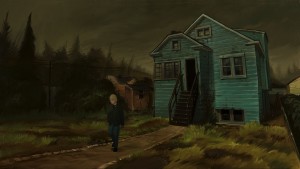 Kurt Cobain: Montage of Heck
Kurt Cobain: Montage of Heck
As mentioned earlier, this was easily my favorite viewing experience, as the energy in the Capitol Theater was vibrant and contagious. This is a film that needs to play big and loud, which will be lost for many who watch it on HBO. As much as I admired the abundant imagination of the filmmakers in bringing Cobain’s archive to life, I did have one lingering conceptual problem with the film. A central argument is that Cobain was very protective of his work, and very careful about how his art was presented to the world. Lack of control of this occasionally led to humiliation, which contributed to his emotional and psychological down fall. Well, obviously Cobain did not intend the public to see much of the work on display in Montage of Heck, which raises at least a few questions about documentary ethics. Sure, if we always respected artists wishes a lot of material would be lost to history (Franz Kafka and Emily Dickinson, just to name two). But the filmmakers simply ignore the issue, and thus they occasionally participate in what Cobain complained about when he was alive.
Uncle Kent 2
Any of the next four films on the list could have been in the Top Ten. Is Uncle Kent 2 objectively better than any of them? Possibly not. But once the salad shaking scene turns into an ode to jiggling man-boobs for the opening credits, you know you’re in for a good time. Uncle Kent 2 is possibly the best coming-of-the-singularity comedy ever made.
The Middle (still good, just not the Top Ten)
I liked all of these, to varying degrees.
Manglehorn
The End of the Tour
Bloomin Mud Shuffle
Young Bodies Heal Quickly*
Blood Below the Skin: Films by Jennifer Reeder*
The Russian Woodpecker
Tomorrow We Disappear*
Stinking Heaven*
Polyester
The Boy and the World*
Bad at Dancing (short)*
Ride the Pink Horse*
Gunman’s Walk
Uncle John
The Disappointments
The first two are just disappointing. The last four are simply not very good. Last year I distinguished only two genuine duds (Commando and Visitors). The increase to four duds might be due to watching more films this year.
White God
We all know that genre filmmaking is the new artsy filmmaking. Even La Sapienza, which I liked, is basically a well executed melodrama. The filmmakers of White God, however, seem to think that simply connecting the genre dots is in itself something interesting. Once the film turns into a revenge thriller, it is neither interesting nor thrilling.
The Astrologer
The problem with the whole “WTF” film thing is that like any drug you quickly build up a tolerance and you soon need stronger and stronger doses to get the same effect. To put it simply, The Astrologer isn’t really that weird. It’s just a poorly executed film with several stylistic features that simply don’t work well. A far more interesting approach to the film, rather that the dismissive “WTF” approach, would be to look at some of the more extreme stylistic decisions and consider them as innovations that did not catch on.
The Keeping Room
A century after D.W. Griffith and company, it’s nice to know that the threat-of-rape narrative is alive and well in contemporary independent cinema. Actually, it’s not nice, and The Keeping Room wallows in some pretty regressive ideological waters despite its surface-level feminism. This would be forgivable if the story were interesting or engaging, but the Yankee villains are so one dimensional that they flirt with self-parody. (Correction, they are two dimensional: they don’t just rape, they rape and/or kill everyone they encounter.) And at a time when the slogan “Black Lives Matter” should resonate for all of us, one African-American death in the film seems so inconsequential and easily forgiven that one wonders what era the filmmakers themselves live in. That said, our own Taylor Hanley had a very different take on the film.
Felt
Just completely, unforgivably tedious. The “payoff” is so redundantly foreshadowed that the misery of watching the last third of the film might be worse than the boyfriend’s fate. And like The Keeping Room, despite a surface level interest in feminism and gender bending, Felt is consistently regressive in terms of gender roles and stereotypes. (Oh, she’s finally “normal” when she’s in a relationship, but of course she goes “psycho” when that relationship is threatened. How progressive.) And one last note: I still can’t believe that this was the film the programmers recommended to horror fans on Bordello of Horror.
Zouzou
The clearest case of “not a film for me” this year. When your 15-year old kid runs out of the house after attempting sex, but you stay in the house to figure out “what went wrong” and ponder over Our Bodies, Our Selves material with your sisters, you know you’re in a French sex comedy. There’s not one genuine, emotionally honest note in the entire film; everything is set up for so-called comic effect. People were laughing throughout, but not me. Just to get another perspective, I asked a specialist in French cinema what she thought of the film. She disliked it even more than I did.
Roar*
Yes a dud, but really a critic-proof film experience. Read my capsule review at Isthmus, and look at Emily Caulfield’s wonderfully impressionistic reaction to the film here at Madison Film Forum.
Nice recap Jimbo. Two things I’d like to add:
1. The seats at Villas Hall are a bad, sick joke. Unless I magically develop the skinny hips of a 18-year old UW coed I won’t be buying tickets to any screenings at Villas again. Honest. Bring back screenings at the museums, please!
2. Surprised that LOVE AT FIRST FIGHT didn’t make your list. Freshest take on young romance I’ve seen in a long time. Really loved it.
Cheers.
John,
Thanks for the kind feedback.
My understanding is that the folks at Vilas know what went wrong in the seat measurements and they plan to correct the problem. Meanwhile, some seats are better than others, so don’t avoid good Cinematheque screenings the rest of the year.
There were Chazen and MMoCA screenings, but not in the basement of the Elvehjem. Technically, that room is not an easy setup.
LOVE AT FIRST FIGHT is high on my list of films to catch up with, along with THE CONNECTION, THE LOOK OF SILENCE, WESTERN, STATIONS OF THE CROSS and several others. My list is everything I had a chance to see so far, except for GUEROS and SPECULATION NATION, which I need to see again because I was ill during those screenings.
Jim K.
Wonderful wrap up, Jim. I so agree. And we cannot praise the new staff too much! Birdie is a professional volunteer coordinator and we volunteers were finally well coordinated! Kinks still left to iron out, but overall, it was a true pleasure!
I know it is not central and crowded in terms of using all 6 theaters, but imagine Sundance being the only venue and the upstairs always open for greenroom, break room, schmoozing, day and eve.
The Sedona FF is held in one big multiplex, so everyone is always running into one another and great fun talking movies.
Early days up and down State St. were the best, eh?
Thanks for the feedback, Gretta. It should be interesting to see the attendance numbers and the Audience Award winners, which should be released tomorrow.
Thank you for mentioning Birdie, Bernadette Watts, by name. I’m going to edit the post to include a shout out to her.
If you look at my comments after last year’s fest, I suggested one possible direction would be to go “all in” with Sundance, or at least for the Festival and Sundance to more fully commit to each other (https://madfilm.org/if-festival-likes-sundance-then-put-a-ring-on-it-wifilmfest-suggestion-box-part-two/)
But, to repeat myself again, I think the first step will be to update the Festival’s overall mission statement, and to have clear goals for downtown (or not) and social functions (or not). Once that is in place, then it would make more sense to re-assess the role Sundance and its second floor might play in what could be a very different Festival experience.
The key will be not just to dwell on the early days, but to figure out different ways of achieving an equally memorable Festival experience.
Jim K.